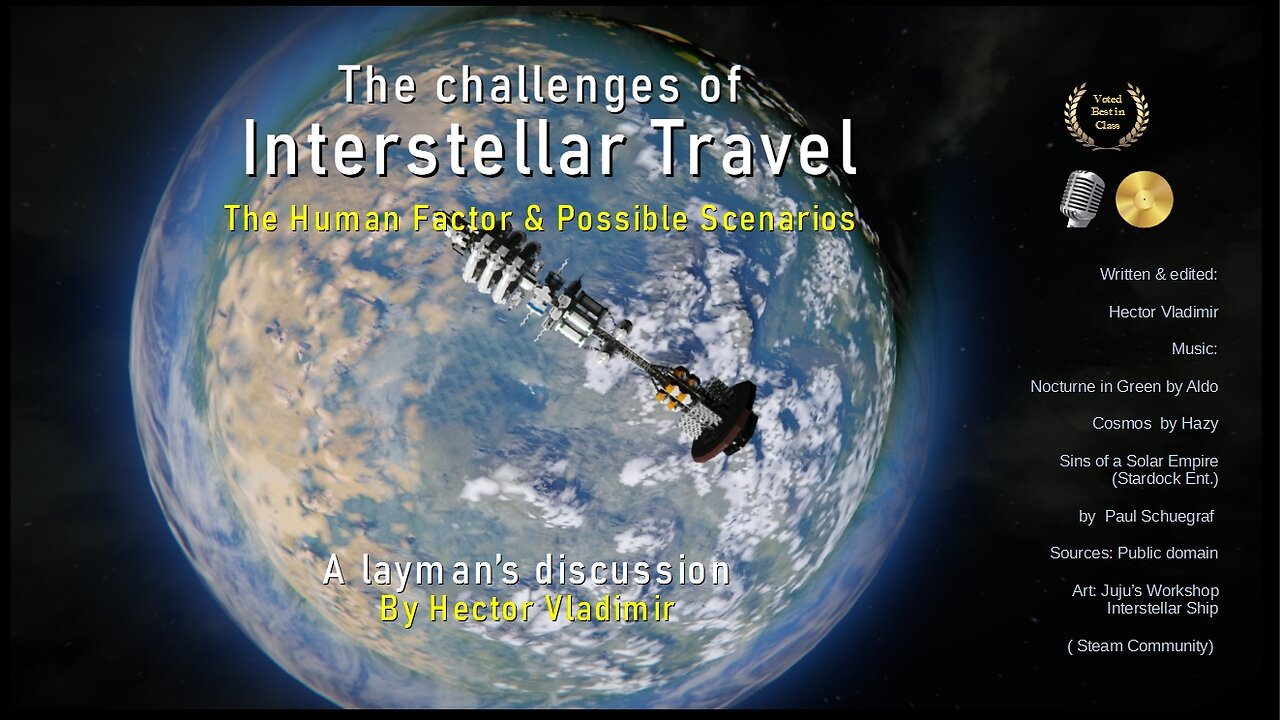Premium Only Content

The Challenges of Interstellar Travel – The human factor & our future possibilities
The greatest hurdle in human interstellar travel is the "human" element itself. Had it not been for our desire to take ourselves to the stars, interstellar travel might have become feasible long ago. Humans are complex organisms with numerous demands, such as a constant supply of air, large quantities of food and water, as well as social interaction and medical care. Meeting these requirements necessitates considerable energy, infrastructure, and payload, adding weight and complexity to already limited rocket capacities. NASA’s five hazards of human spaceflight—radiation, gravity, isolation, distance from Earth, and closed hostile environments—become even more daunting in interstellar contexts. Disturbingly, proposed solutions, like "animated suspension" or "warp drives," remain in the realm of science fiction. The challenges posed by the "human factor" complicate interstellar missions extensively. While we could focus on purely robotic missions, to circumvent these issues, here it is essential to address the five significant challenges that remain salient for human interstellar travel.
Cosmic radiation poses significant challenges for interstellar flight, worsened by extended travel durations, high speeds, and vast distances. The absence of gravity also presents health risks for the crew and future generations. As humans venture farther from Earth, where our biology and psychology originated, adaptation to new environments becomes inevitable, albeit potentially detrimental. Initial changes may lead to chaotic or hostile behaviors, and managing such responses poses further concerns. The safety of reproduction in space remains uncertain, complicating human survival, given our physiological aversions to a zero-gravity environment. Additionally, maintaining harmony among crew members in confined spaces is challenging, as humans often exhibit negative emotions like anger and jealousy. With no known precedents for long-term cooperative behavior beyond a year, the psychological impacts on mission success are unpredictable. Interstellar crew dynamics will also raise civic and ethical questions regarding governance and cultural interactions, particularly as voyages might become autonomous and independent, necessitating discussions about leadership structures, language, and potential conflicts among diverse backgrounds.
In the distant future, if various challenges are addressed, humanity may have the opportunity to visit another star system. However, the reality could differ from our expectations, with humans potentially playing a subordinate role as observers, while advanced machines undertake the journey. Our once-held capabilities may have evolved into sophisticated technology. An alternative could involve transferring information rather than physical humans to the stars, as human biology and psychology are fragile. Thus, machines might convert our data—durable and capable of surviving the journey—to be interpreted by other advanced systems upon arrival. Another concept is that human DNA could be transported, allowing for the generation of humans at the destination, eliminating the need for traditional gestation. Ultimately, embarking on such interstellar missions will necessitate contemplating a fundamental question: Why? These factors and possibilities are all addressed here; in my concluding chapter of the series "Challenges of Interstellar Travel: The Human Factor".
Hazards of Space Travel
Channel https://www.youtube.com/@sparkyae1
Playlist https://www.youtube.com/playlist?list=PLyWqApEqGtc5foyq8ccjATrgVnt3Gy9KD
Channel https://www.youtube.com/@hbcsolarpvtech
Channel https://www.youtube.com/@hbcsolarpvtechbyron
Hector Vladimir 2025©
-
 40:24
40:24
The Connect: With Johnny Mitchell
2 days ago $17.41 earnedInside The WORST Drug-Infested Slums Of Medellin, Colombia
54.5K27 -
 4:14
4:14
GritsGG
12 hours ago2 Warzone Easter Eggs! How to Find Them EASILY!
994 -
 LIVE
LIVE
Lofi Girl
2 years agoSynthwave Radio 🌌 - beats to chill/game to
157 watching -
 1:45:43
1:45:43
Man in America
12 hours agoThe DISTURBING Truth About Parasites — Live Q&A w/ Dr. Jason Dean
58.8K37 -
 7:13:47
7:13:47
SpartakusLIVE
8 hours ago#1 Mountain of Muscle with HUGE Legs saves your weekend from complete BOREDOMNight HYPE
36.7K1 -
 47:42
47:42
Sarah Westall
9 hours agoFreedom or Slavery? AI will Change Everything w/ Trump Senior Advisor Marc Beckman
46.5K9 -
 2:23:20
2:23:20
vivafrei
16 hours agoEp. 285: Visa Revocation No-Go! Sortor Arrested! Ostrich Crisis! 2A Win! Comey Defense & MORE!
108K101 -
 5:55:11
5:55:11
CassaiyanGaming
6 hours ago🟢LIVE - VISITING GOOB LAGOON! - Will They Rip Me Off?!? Waterpark Simulator
39.4K3 -
 5:42:21
5:42:21
EricJohnPizzaArtist
6 days agoAwesome Sauce PIZZA ART LIVE Ep. #64: Robbie “The Fire” Bernstein
43.9K2 -
 2:23:58
2:23:58
Nerdrotic
9 hours ago $14.34 earnedDeDunking the Debunkers with Dan Richards | Forbidden Frontier #119
57.7K14
